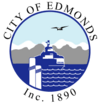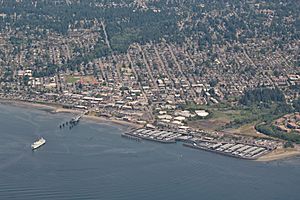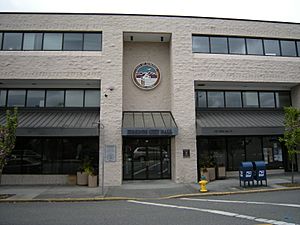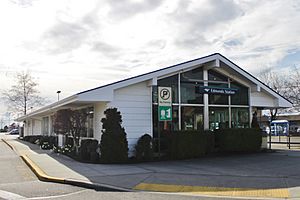Edmonds, Washington facts for kids
Quick facts for kids
Edmonds, Washington
|
||
|---|---|---|
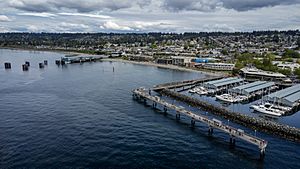
Aerial view of downtown Edmonds near the Washington State Ferries terminal
|
||
|
||
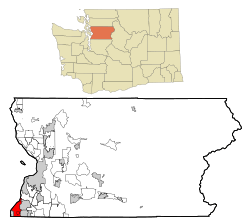
Location of Edmonds, Washington
|
||
| Country | United States | |
| State | Washington | |
| County | Snohomish | |
| Established | 1876 | |
| Incorporated | August 14, 1890 | |
| Government | ||
| • Type | Mayor–council | |
| Area | ||
| • Total | 10.01 sq mi (25.92 km2) | |
| • Land | 8.92 sq mi (23.09 km2) | |
| • Water | 1.09 sq mi (2.82 km2) 10.9% | |
| Elevation | 66 ft (20 m) | |
| Population
(2020)
|
||
| • Total | 42,853 | |
| • Estimate
(2023)
|
42,701 | |
| • Density | 4,778.49/sq mi (1,844.90/km2) | |
| Time zone | UTC-8 (Pacific (PST)) | |
| • Summer (DST) | UTC-7 (PDT) | |
| ZIP codes |
98020, 98026
|
|
| Area code | 425 | |
| FIPS code | 53-20750 | |
| GNIS feature ID | 1512180 | |
Edmonds is a city in Snohomish County, Washington, United States. It is located in the southwest part of the county. The city faces Puget Sound and the Olympic Mountains to the west. Edmonds is part of the Seattle metropolitan area. It is about 15 miles (24 km) north of Seattle. It is also 18 miles (29 km) southwest of Everett. In the 2020 U.S. census, Edmonds had 42,853 residents. This makes it the third largest city in Snohomish County.
Edmonds was started in 1876 by a logger named George Brackett. He bought the land from an earlier settler. The city officially became a city in 1890. This was just before the Great Northern Railway arrived. Early jobs in Edmonds were mostly in shingle mills and logging. These industries operated until the 1950s. Later, the hills around Edmonds became suburban neighborhoods. These areas were then added to the city. Edmonds is now a center for the arts. It has museums, special facilities, and big yearly festivals.
The city is connected to nearby areas by two state highways. It also has the state ferry system. This system runs a ferry route to Kingston. Public transportation in Edmonds is focused around the downtown train station. This station serves Amtrak and Sounder commuter trains. There are also several Community Transit bus routes. These buses travel through the neighborhoods outside downtown.
Contents
History of Edmonds
Early Days and Growth
Before the 1800s, the Suquamish tribe lived in the Edmonds area. They gathered food and fished near the flat beach where downtown Edmonds is today. There is no proof of a permanent village, but people believe a fishing village might have been there.
In 1841, an exploration team led by Charles Wilkes mapped the Edmonds area. They named a spot "Point Edmund." This is now Point Edwards. In 1866, Pleasant Ewell claimed 147 acres (59 ha) of land here. This land was sold several times. Finally, George Brackett, a logger from Canada, bought it in 1872. He paid $650. Brackett supposedly found the future site of Edmonds in 1870. He was looking for logging areas when a storm blew his canoe ashore.
Brackett and his family moved to Point Edmund in 1876. They wanted to create a town. He drained a marsh near the water and started logging. This area was known as "Brackett's Landing." More settlers arrived over the next few years. This led to building a wharf and a general store by 1881. In 1884, the settlement was mapped out. It also got its first post office. It was named "Edmonds." This name might have been a mistake for Point Edmund. Or it could have been named after George Franklin Edmunds, a U.S. Senator whom Brackett admired.
By the end of the 1880s, Edmonds had a schoolhouse, sawmill, hotel, and drug store. The Town of Edmonds officially became a city on August 14, 1890. This happened after residents voted on August 7. A popular story says Brackett added his two oxen's names to the census. This was to make sure the town had enough people (300) to become a city. Edmonds is the oldest city in Snohomish County. Brackett was elected mayor for a few months. The new town council passed rules about saloons and gambling.
In the same year, Edmonds was chosen as a stop for the Seattle and Montana Railroad. This railroad later became part of the Great Northern Railway. This made real estate investors interested. The Minneapolis Realty and Investment Company bought 455 acres (184 ha) from Brackett for $36,000. They built a new hotel and wharf. The railway arrived in 1891. However, it did not cause a land rush. The investment plan failed during the Panic of 1893. Brackett had to take back the land.

Edmonds was supported by four shingle mills. These mills did well in the 1890s. An iron foundry also made steel plates for shingles. By 1908, the town had its own water system, electricity, paved streets, and telephone service. In September 1908, Edmonds voted to become a third-class city. It had 1,546 residents. The city tried to get a branch of the interurban line. This line would have connected Everett to Seattle. It would have added to the passenger steamships and trains. A big fire on July 8, 1909, destroyed one block of buildings on Main Street. It caused $20,000 in damage. After the fire, a city council member bought the destroyed buildings. They were replaced by a two-story concrete building.
The first car owned by an Edmonds resident arrived in 1911. The North Trunk Road was completed through modern-day Lynnwood. A road connecting to Edmonds was finished in 1915. Stagecoach lines also reached the city. Car ferry service started in 1923. This was the start of the Kingston ferry. This ferry was later bought by the Puget Sound Navigation Company. It continued to serve the city. In the 1920s, Edmonds made its wharf and ferry dock bigger. The Union Oil Company (later Unocal) bought land for an oil terminal in 1922. Another big fire hit downtown Edmonds on April 11, 1928. It damaged buildings on the same block as the 1909 fire. Even with less local timber, the sawmills were still the main industry in the 1920s. During the Great Depression, most mills kept working. Federal projects also helped. These included new streets, parks, and additions to the high school.
Modern Edmonds
By 1951, most of Edmonds' mills closed. This was because new materials for roof shingles became popular. Also, timber was harder to find. New companies took the place of the mills. These included an aluminum factory and an asphalt refinery. The waterfront was redeveloped by the Port of Edmonds. This port was created in 1948. In the 1950s and 1960s, the Port built a breakwater, a marina, a public beach, and a new ferry terminal.
The hills around downtown Edmonds became suburban neighborhoods. These areas were added to the city. Edmonds reached its current eastern border in May 1959. By 1963, the city had grown a lot. It had a population of 19,000. This made it the second largest city in Snohomish County. Even with growth, Edmonds limited new apartment buildings. This was to keep the downtown area "rural-like." By the end of the 1960s, Edmonds also had a new hospital, a community college, and a civic center.
In the 1970s, fewer businesses were in downtown Edmonds. Suburban shopping centers attracted customers away. Some downtown buildings were torn down and replaced. Then, a movement started to save and restore old buildings. The city government supported this. The "Main Street Project" helped restore empty stores. It also brought restaurants to the city in the late 1980s. This helped downtown become lively again. Parts of the waterfront became a public beach, Brackett's Landing Park. A public fishing pier opened in 1979. It was the first saltwater fishing pier in Washington. Edmonds celebrated its 100th birthday in 1990.
The Point Edwards oil terminal closed in 1991. Edmonds and Snohomish County wanted to redevelop the 53-acre (21 ha) site. The city wanted a new transportation hub there. This would include a ferry terminal and train station. The county suggested a sewage treatment plant. The city and citizens were against the sewage plant. It was moved to a different site in 2003. The transportation plan was put on hold because costs went up. The hilltop part of the site was cleaned up in the 2000s. It became condominiums that opened in 2007 and 2008.
Geography and Nature
Edmonds is in the southwest corner of Snohomish County. It is a suburb of Seattle. The city is bordered by Puget Sound and the city of Woodway to the west. To the south, it borders Shoreline in King County. The city's eastern border is with Mountlake Terrace and Lynnwood. Edmonds has a total area of about 10 square miles (26 km²). About 9 square miles (23 km²) is land, and 1 square mile (2.6 km²) is water.
Edmonds has about 5 miles (8 km) of shoreline. Several small streams flow into the Puget Sound. The city's main shopping areas are Downtown Edmonds and the State Route 99 corridor. Downtown Edmonds has great views of Puget Sound and the Olympic Mountains. The city also has several neighborhoods with their own small shopping areas. These include Firdale, Five Corners, Perrinville, Seaview, Sherwood, and Westgate.
Economy and Jobs
As of 2015, Edmonds had about 22,152 people working. Most residents travel to nearby cities for work. About 11 percent go to Seattle, 6 percent to Lynnwood, and 6 percent to Everett. Only about 11.7 percent of residents work within Edmonds itself. The average trip to work for Edmonds residents was about 31 minutes. Most people (71 percent) drove alone.
The most common jobs for Edmonds residents are in education and health services. These employ 23 percent of workers. Retail (stores) employs 13 percent, and professional services (like lawyers or consultants) employ 12 percent. The closest big shopping malls are Alderwood in Lynnwood and Aurora Village in Shoreline.
Edmonds has over 13,000 jobs. About 70 percent of these jobs are in the services sector. This includes health care and professional services. Other big industries are retail (12%), education (6%), and construction (4%). The city's largest employers are the Edmonds School District, Swedish Medical Center, and large stores. Car dealerships along State Route 99 bring in a lot of money for the city.
People and Population
| Historical population | |||
|---|---|---|---|
| Census | Pop. | %± | |
| 1900 | 474 | — | |
| 1910 | 1,114 | 135.0% | |
| 1920 | 936 | −16.0% | |
| 1930 | 1,165 | 24.5% | |
| 1940 | 1,288 | 10.6% | |
| 1950 | 2,057 | 59.7% | |
| 1960 | 8,016 | 289.7% | |
| 1970 | 23,684 | 195.5% | |
| 1980 | 27,679 | 16.9% | |
| 1990 | 30,744 | 11.1% | |
| 2000 | 39,515 | 28.5% | |
| 2010 | 39,709 | 0.5% | |
| 2020 | 42,853 | 7.9% | |
| 2023 (est.) | 42,701 | 7.5% | |
| U.S. Decennial Census | |||
Edmonds is the third largest city in Snohomish County. In the 2010 U.S. census, it had 39,709 people. The city's population was estimated to be over 40,000 in 2015. It is growing by about 1 percent each year. Between 1960 and 1990, Edmonds' population grew a lot. It went from 8,000 to over 30,000. This was due to new areas being added to the city and natural growth.
This growth also brought more Asian immigrants to Edmonds. Many of them are Koreans. They now make up about 7 percent of the population. They are the largest non-white group in the city. The city's population is expected to reach 45,000 by 2035.
In 2012, the average family income in Edmonds was $93,125. The income per person was $43,048. About 5.2 percent of families and 9 percent of all people lived below the poverty line. This included 14 percent of those under 18 and 5 percent of those 65 or older.
Population Details (2010)
In 2010, there were 39,709 people living in Edmonds. There were 17,381 households. About 25 percent of households had children under 18. Most households (49 percent) were married couples. The average household had 2.26 people. The average family had 2.82 people.
The average age in Edmonds was 46.3 years. About 18.6 percent of residents were under 18. About 19.1 percent were 65 or older. The city has more older residents than the average for the county. The population was 47.3 percent male and 52.7 percent female.
City Government
Edmonds has a mayor–council government. This means it has an elected mayor and a city council with seven members. The mayor is elected for a four-year term. This is a nonpartisan position, meaning candidates don't run as part of a political party. Mike Rosen became mayor in 2023. The city council members are elected to four-year terms. They make the city's rules and policies.
The city government has 224 full-time employees. Its yearly budget is $98 million. This money mostly comes from property and retail sales taxes. The budget pays for city departments like parks and recreation, public works, water, the municipal court, and emergency services. The city's fire department joined a regional service called South County Fire in 2010.
At the national level, Edmonds is part of the 2nd congressional district. At the state level, the city is in the 21st and 32nd legislative districts. Edmonds is also part of the Snohomish County Council's 3rd district.
Culture and Community
Arts and Events
Edmonds is known as a big center for the arts in Snohomish County. It has many galleries and art facilities. The city started the Edmonds Art Commission in 1975. It has since developed a public arts program. The city has 35 outdoor art pieces and 22 flower pole structures. It also has several buildings for different arts.
One project was turning the old Edmonds High School building into the Frances Anderson Cultural and Leisure Center in 1979. This center offers art classes, shows, ballet, community events, and sports. The city also updated the high school auditorium into the Edmonds Center for the Arts in 2006. This is now a place for plays, concerts, and movies.
The yearly Edmonds Arts Festival has been held since 1957. It takes place over Father's Day weekend in June. It is one of the biggest festivals in the Pacific Northwest. About 75,000 people visit. It has 200 artists with booths along Main Street. The Cascadia Art Museum opened in 2015 in downtown Edmonds. It focuses on art from the Northwest region. Downtown Edmonds also has an old movie theater from the 1920s. It is still owned and run independently.
Edmonds has several active performing arts groups. The Driftwood Players perform plays at the Wade James Theatre. The Phoenix Theatre is in Firdale Village. The city also hosts the yearly Edmonds Jazz Connection in late May. This event features school jazz groups and professional musicians. In November 2018, Edmonds became the first creative district in Washington.
A main landmark in the city is a small fountain in the middle of a roundabout on Main Street. The first fountain was put in in 1973. It was criticized for being ugly. In 1998, it was destroyed in an accident. A temporary gazebo replaced it. This gazebo was popular. It was replaced with a bronze structure in 2000. This was also destroyed by a driver five years later. The gazebo was rebuilt in 2006 and is still there.
Edmonds has a weekly farmers' market from June to October on Saturdays. The city also has several summer festivals. These include the Edmonds Waterfront Festival in early June, the Edmonds Art Festival in mid-June, the Edmonds in Bloom garden festival in July, and the Taste of Edmonds food festival in August.
Local Media and Library
Edmonds used to have a weekly newspaper called the Edmonds Tribune-Review. It ran until 1982. Today, Edmonds is served by The Everett Herald and The Seattle Times. Since 1986, the Edmonds Beacon has published a free weekly newspaper. Edmonds also has a local blog, MyEdmondsNews.com, which covers city news.
The Edmonds library started in 1901. It moved into a permanent building in 1911. This building was paid for by Andrew Carnegie. The Carnegie Library was both a library and city hall until 1962. The city built a new library in 1982. It has 20,000 square feet (1,858 m²) of space. It also has an outdoor plaza with views of Puget Sound. The library reopened on January 13, 2024. It has 17,566 square feet (1,632 m²) of reading space, community areas, and a children's section.
Parks and Recreation
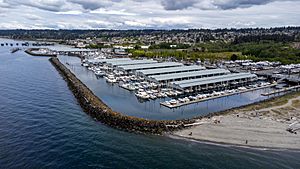
Edmonds has 23 city parks. These parks have 189 acres (76 ha) of open space. There are also facilities shared with the school district and county. Downtown Edmonds has several big parks. These include the public beach at Brackett's Landing and City Park. A small 9/11 memorial is at a fire station near downtown. It was dedicated in 2015.
The city also has dog parks, sports fields, a seasonal swimming pool, and a skate park. Edmonds Stadium, which hosted high school sports, closed in 2017. The Edmonds senior center opened in 1967. A new building, the Edmonds Waterfront Center, opened in 2021.
The city also has urban forests and natural reserves. These areas protect the original plants and have hiking trails. Edmonds Marsh Park has 28 acres (11 ha) and protects one of the few remaining saltwater marshes in the state. It is home to 225 bird species. The largest wooded area is Southwest County Park. It has 120 acres (49 ha) of land.
The Port of Edmonds manages the city's public marina. It has 890 slips and is one of the largest in the Puget Sound region. The marina is dredged to a depth of 13 feet (4.0 m). North of Brackett's Landing, the city has a 27-acre (11 ha) marine park. This park is called the Edmonds Underwater Park. It was made mainly for scuba diving. The park attracts 25,000 visitors each year. It is one of the most popular diving spots in Washington. The park has man-made reefs, several shipwrecks, and habitats for sea life.
Historical Preservation
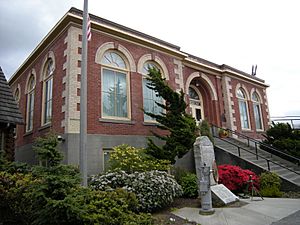
The Carnegie Library is the only building in Edmonds on the National Register of Historic Places. It was added in 1973. It now houses the Edmonds Historical Museum. This museum is run by the Edmonds–South Snohomish County Historical Society.
The city government created its own historical commission in 2007. It now has a separate list of historic places with 18 buildings. The city's historic designation does not have strict rules about design or building changes. It mainly includes historic homes and businesses.
Sister City
Edmonds has one sister city. It is Hekinan in Japan. This relationship started in 1988. A totem pole and a plaque on the waterfront remember this connection. Three times a year, the two cities send visiting groups. These include exchange students. They also regularly exchange gifts and holiday greetings.
Notable People from Edmonds
- Guy Anderson, painter
- Steven W. Bailey, actor
- Brian Baird, former U.S. Congressman
- Jean-Luc Baker, ice dancer and Olympian
- Brian Basset, cartoonist
- David Bazan, musician
- Sean Beighton, Olympic curling coach and former curler
- George Benson, former Seattle city councilmember
- Alan Stephenson Boyd, former U.S. Secretary of Transportation
- Maria Cantwell, U.S. Senator
- Ryan Couture, MMA fighter
- Annie Crawley, underwater photographer and filmmaker
- Andra Day, singer and actress
- Anna Faris, actress
- Vern Fonk, insurance salesman
- Susan Gould, civil activist and state legislator
- Morris Graves, artist
- Dave Hamilton, professional baseball player
- Bridget Hanley, actress
- Missouri T. B. Hanna, suffragist and newspaper publisher
- Chris Henderson, professional soccer player
- Lori Henry, soccer player and coach
- Ken Jennings, author and Jeopardy! host
- Erik Scott Kimerer, voice actor
- Corey Kispert, professional basketball player
- Sota Kitahara, professional soccer player
- Marko Liias, state senator
- Todd Linden, professional baseball player
- Jay Park, musician
- Paull Shin, state senator
- Rick Steves, travel author and television host
- Rosalynn Sumners, figure skater and Olympic medalist
- Scott Uderitz, professional soccer player
- Helen Westcott, actress
Education in Edmonds
Edmonds is part of the Edmonds School District. This district also serves Lynnwood, Mountlake Terrace, and Woodway. The city is home to Edmonds Woodway High School. This school was formed in 1990. It moved to a new campus in 1998. The high school has 1,800 students. It offers an IB Diploma Programme. The school district also has an alternative high school, Scriber Lake. There are also two K–8 schools, five elementary schools, and two combined elementary–middle schools in Edmonds.
Edmonds College is located near Edmonds, but it is actually in Lynnwood. Edmonds used to have a private college called Puget Sound Christian College. It operated from 1977 to 2001 in the old Edmonds High School building. Edmonds also has several private schools for different grade levels.
City Services and Transport
Transportation Options
Edmonds has several ways to get around. These include roads, railroads, ferries, and buses. The city's ferry terminal is at the west end of Main Street. It serves a ferry route to Kingston. The Edmonds train station is near the ferry terminal. It serves Amtrak's Cascades and Empire Builder trains. It also serves Sound Transit's Sounder commuter train. These trains use the BNSF Railway, which runs along the Edmonds waterfront. This railway is mostly used for freight.
Two state highways, State Route 104 and State Route 524, connect downtown Edmonds to other areas. Another state highway, State Route 99, runs north–south in eastern Edmonds. It connects the city's shopping area to Seattle and Everett.
Community Transit provides public transportation in Edmonds. Its local buses run on major streets. They connect downtown Edmonds to transit hubs. It also runs the Swift Blue Line on State Route 99. This is a bus rapid transit service. Until 2024, Community Transit had express buses to Downtown Seattle. These were replaced by the Link light rail extension to Lynnwood. A new express bus now connects Downtown Edmonds to Mountlake Terrace station.
Utilities and Health
Electric power in Edmonds comes from the Snohomish County Public Utility District (PUD). In 2017, the city promised to use only renewable energy sources for electricity by 2025. Puget Sound Energy provides natural gas to homes and businesses.
The city's tap water comes from the Alderwood Water District. This water comes from Everett's Spada Lake Reservoir. The city government manages its own sanitary sewer and wastewater treatment services. This includes a treatment plant downtown. Wastewater is also sent to the regional Brightwater plant. Garbage, recycling, and yard waste services are handled by private companies.
Edmonds has one general hospital, which is a branch of Swedish Health Services. It opened on January 26, 1964, as Stevens Memorial Hospital. It was named after Washington territorial governor Isaac Stevens. It became a public hospital in 1967. The hospital was expanded in 1972. In 2010, Swedish began leasing the hospital. The public hospital district then became the Verdant Health Commission. It now focuses on public health.
See also
 In Spanish: Edmonds para niños
In Spanish: Edmonds para niños


